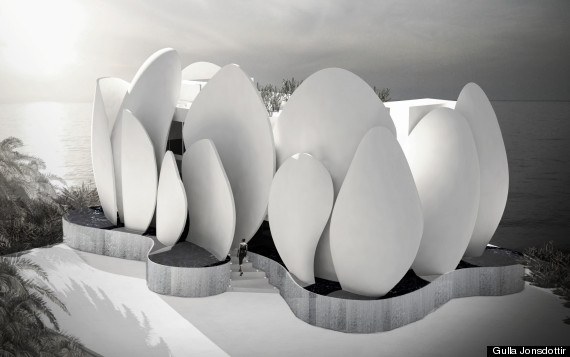Gulla Jonsdottir was only 19 when she moved from Iceland to Los Angeles to study architecture. In the years since she has built a reputation from her innovative and painfully sleek designs, in which nature, art, travel and style harmoniously cohabitate.
When we think of art museums and galleries, oftentimes our aesthetic judgment is focused on the artwork. But breezy structures like Los Angeles' Getty Center are as crucial to the artistic experience as your favorite painting. We asked Jonsdottir some questions about the intersection between architecture and art, her upcoming project in Beirut and the challenges of being a female architect. Scroll down for a slideshow.

HP: How did you become involved with the Beirut projects?
GJ: I have gotten acquainted with Lebanese people in Los Angeles and was working with a Lebanese Engineering firm here on another project, which recommended me to the partners of the first building. When they decided to hire me, they knew that a friend of theirs was building another building next to them and they told me that they didn’t want an ugly building next to theirs, so they introduced me to this client, who ended up hiring me as well. I’m not sure if it was pure pressure, but so far it’s become a great working relationship with both clients as these two buildings stand next to one another on the beach in the center of Beirut.
HP: Are you incorporating any ideas or traditions from Beirut's history or culture?
GJ: Yes I am, and have to say I was very intrigued by my first visit to Beirut and I absolutely fell in love with their culture, their joie de vivre and food. For the white building, I’m incorporating Arabic calligraphy into one of the concrete petal shapes to allow for interesting views. For the black building, shapes of shells found on the beach form a large wing like structure cladding the corner of the building. The shape of the wing made up of three sizes of cast concrete shell shapes, also in a way reminds me of a large feather hat I imagine ladies would have worn back in the day when Beirut was considered the Paris of the middle East. Beirut is back to become that city again, so I think a celebration of life and exuberant living plays a role in the shape of these two buildings.
HP: You have mentioned that fashion plays a role in your architectural visions. How is this the case?
GJ: I like to look through fashion magazines and I am sometimes inspired by a certain dress or fabric but in my mind it’s a huge backlit concrete wall casting interesting shadows through a space or a floor pattern that can be found in the stitching of clothing and handbags. The strapping of shoes can turn out to be a fun wrapping of columns or it can be incorporated into a piece of furniture. I’m also inspired by certain pieces of jewelry and for instance for the jewelry store I’m designing for a Lebanese jewelry designer on Rodeo Drive, (that I happened to meet on my trip to Beirut), the design is based on his jewelry and the storefront window resembles a faceted diamond protruding out to the street, set in a tile of black petrified wood. I call it the “Diamond in the Rough” on Rodeo Drive.
HP: What are the hurdles facing female architects today?
GJ: Architecture is very much a male dominated world, so I consider myself lucky to be working in this field with an all female staff actually. I try not to think of hurdles or problems, only solutions and how I can possibly contribute to the world through Design.
HP: You have been involved in design for the Getty Center and Gagosian Gallery, among many others. What challenges are specific to designing a structure that will interact with art?
GJ: Art museums are very specific, and the lighting plays a large role here as well as large floor and wall spaces to display the art. At the Getty the lighting changed with the sunlight through louvers that moved to allow optimal lighting for every hour of the day. Another interesting thing about the Getty was how the galleries are divided so you can go outside to get fresh air in between viewings. I think this is important as your senses can be overwhelmed after hours of taking in such beauty in a large Museum.
HP: What is a building you wish you had designed?
GJ: I think I have to say the Bird’s Nest Olympic stadium in Beijing. I would love to be involved with the Olympics at some point in my career, as I think the grace and the limits these athletes can push their bodies is amazing. I’m also always inspired by the shapes of the human form and how it can translate into sensual Architecture.
See a slideshow of her work below, and let us know your thoughts in the comments section.
